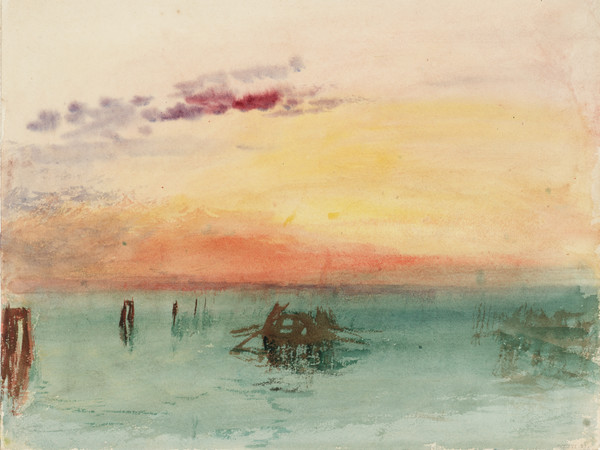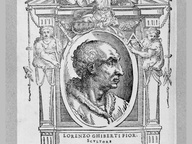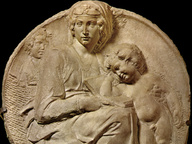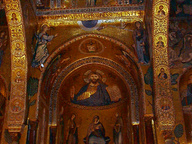Turner. Works from the Tate
Joseph Mallord William Turner, Venice: Looking across the Lagoon at Sunset, 1840, Watercolour on paper, 12 x 9.6", Tate, Accepted by the nation as part of the Turner Bequest 1856 | Courtesy of Chiostro del Bramante 2018
From 22 Marzo 2018 to 26 Agosto 2018
Rome
Place: Chiostro del Bramante
Address: Via Arco della Pace 5
Times: Mon - Fri 10 am - 8 pm | Sat - Sun 10 am - 9 pm | The ticket office close one hour before
Responsibles: David Blayney Brown
Organizers:
- CON IL PATROCINIO DI
- Regione Lazio
- Roma – Assessorato alla crescita culturale
- Ambasciata Britannica
- British Council
- PARTNER TECNICO
- Trenitalia
- Ticketone
- Ceccotti Flowers
- MEDIA COVERAGE
- ARTE.it e Wanted in Rome
Ticket price: Full 14 € | Reduced 12 € | 6-18 years 9 € | Free under 6
Telefono per informazioni: +39 06 6880 9035
E-Mail info: infomostra@chiostrodelbramante.it
Official site: http://https://www.chiostrodelbramante.it/
Chiostro del Bramante, in partnership with the Tate in London, will be hosting 'TURNER. Works from the Tate’ from the end of March until the end of August 2018. This major monographic exhibition will be devoted to one of Britain’s most important painters: Joseph Mallord William Turner.
The event – curated by David Blayney Brown, Manton Curator of British Art 1790‒1850 – marks the start of a major collaboration between the Tate in London and Chiostro del Bramante and will provide an exceptional opportunity to see some key works spanning the entire career of the famous British artist, which have not been seen in Rome for more than fifty years or in any Italian museum for twelve years. A unique collection of ninety-two works, including watercolours, drawings and sketchbooks, as well as a selection of oil paintings, displayed together in Italy for the first time. The works have been selected from the vast legacy that comprises around 30,000 works on paper, 300 oil paintings and 280 sketchbooks, known as the 'Turner Bequest’, donated to Great Britain after the artist’s death in 1851 and mostly conserved at Tate Britain. The bequest includes the entire body of works housed in the artist’s personal studio and produced over the years for his “own pleasure”, to cite the beautiful words used by the critic John Ruskin.
An aesthetic and visual pleasure, in which memories of journeys, emotions and fragments of landscapes seen during his long stays abroad illustrate the development of Turner’s stylistic language and his incessant poetic research, focused on experimenting with the expressive potential of light and colour. The exhibition therefore allows us to explore Turner’s entire artistic production and reveals how, in his drawings of topographic and architectural subjects, he gradually developed an extremely personal style, including an extraordinary range of new iconographical and stylistic elements in his works based on his refined passion for light, colour and atmospheric effects.
The exhibition at Chiostro del Bramante – divided into six thematic sections – focuses on the important role played by watercolours in defining Turner’s style, demonstrating how his expressive research was a precursor to the art of the Impressionists.
The intimate and personal character of the works on display will also provide an opportunity to explore the man himself, as well as the artist, gaining an understanding of how the radical developments in Turner’s style actually anticipated the stylistic trends of the late 19th century. From his love of seaside towns to his interest in depicting atmospheric English and Alpine landscapes, and his detailed study of domestic interiors and architectural reliefs. Mindful of his numerous trips, many of which were to Italy, and driven by a highly innovative spirit, the artist devoted himself tirelessly to experimentation, particularly in watercolours, with a compositional and stylistic freedom and an innovative and surprising use of colours that led his peers to believe that Turner "appeared to paint with his eyes and nose as well as his hand.”
Joseph Mallord William Turner (1775‒1851)
A precocious talent, Joseph Mallord William Turner was born in London in 1775 and was soon encouraged to follow in his father’s footsteps as a painter. Indeed, despite being in financial straits, his father sent him to the prestigious Royal Academy in 1789, where he was made professor of perspective in 1807.
In addition to his academic studies, J.M.W. Turner also worked with a number of architects and explored the landscape directly, painting en plein air. Initially an engraver and watercolour artist, Turner soon devoted himself to oil painting.
His irrepressible desire to travel, to constantly seek out places he could depict on paper, led him to be a landscape artist faithful to the topographic tradition, particularly focusing on the English countryside. However, he soon abandoned this technique in favour of a freer and more lyrical vision that transcended mere realism. From his very first journeys, Turner realised the importance of painting en plein air. As a result, from the middle of 1790, he began travelling with his sketchbook in the summer and then working in his studio in the winter, completing the pictures he had started during earlier months.
He worked for Dr Monro, a collector and patron of young artists, for a period of time, during which he copied sketches by the well-known landscape artist J.R. Cozens. Turner also began developing an interest in the aesthetics of the sublime and picturesque, to which he added his own unconditional admiration for Nicolas Poussin and, above all, for Claude Lorrain. Nevertheless, while not forgetting the lessons imparted by past masters, Turner developed a highly personal manner of painting, exploring atmospheric and lighting effects in ever greater depth. He was particularly attracted by Johann Wolfgang von Goethe’s ‘Theory of Colours’ and by the research of Isaac Newton and began concentrating on the emotional component of colour, coming up with his own diagram that he used during his perspective lessons to show students how to use colour to create an illusion of depth in painting.
He had a particularly close relationship with Italy, which he visited for the first time briefly in 1802, before returning in 1819 and staying in Venice, Rome and Naples, cities that provided him with a full perception of the intense luminosity of Italian landscapes and proved a decisive experience in the development of his style. Turner produced some wonderful views of the Venetian lagoon at the height of his career, which are some of his most famous works. During this period, the theme of colour and light was central to Turner’s style and he devoted the rest of his life to searching for subjects and atmospheres to be depicted as reflections of his inner world. Within a space and light free from all traditional perspective arrangements, forms lose consistency and pure colours become the absolute protagonists of his works, along with light.
Like no one before him, Turner succeeded in exploiting the transparency and light typical of this genre of painting, managing to produce unparalleled effects both before and since. By painting en plein air, the painter grasped the eloquent moment: a point of light, a gust, an unrepeatable instant that revealed the arcane. Deemed to be an extraordinary artist ever since his own time, J.M.W. Turner anticipated aesthetic trends such as Impressionism – Claude Monet is known to owe a debt to Turner, having seen his watercolours in his studio and at a temporary exhibition in the National Gallery during his trip to London in 1871 ‒ and has had a profound influence on contemporary artists such as Mark Rothko and Olafur Eliasson. Even today, he still continues to amaze anyone who sees his works.
The event – curated by David Blayney Brown, Manton Curator of British Art 1790‒1850 – marks the start of a major collaboration between the Tate in London and Chiostro del Bramante and will provide an exceptional opportunity to see some key works spanning the entire career of the famous British artist, which have not been seen in Rome for more than fifty years or in any Italian museum for twelve years. A unique collection of ninety-two works, including watercolours, drawings and sketchbooks, as well as a selection of oil paintings, displayed together in Italy for the first time. The works have been selected from the vast legacy that comprises around 30,000 works on paper, 300 oil paintings and 280 sketchbooks, known as the 'Turner Bequest’, donated to Great Britain after the artist’s death in 1851 and mostly conserved at Tate Britain. The bequest includes the entire body of works housed in the artist’s personal studio and produced over the years for his “own pleasure”, to cite the beautiful words used by the critic John Ruskin.
An aesthetic and visual pleasure, in which memories of journeys, emotions and fragments of landscapes seen during his long stays abroad illustrate the development of Turner’s stylistic language and his incessant poetic research, focused on experimenting with the expressive potential of light and colour. The exhibition therefore allows us to explore Turner’s entire artistic production and reveals how, in his drawings of topographic and architectural subjects, he gradually developed an extremely personal style, including an extraordinary range of new iconographical and stylistic elements in his works based on his refined passion for light, colour and atmospheric effects.
The exhibition at Chiostro del Bramante – divided into six thematic sections – focuses on the important role played by watercolours in defining Turner’s style, demonstrating how his expressive research was a precursor to the art of the Impressionists.
The intimate and personal character of the works on display will also provide an opportunity to explore the man himself, as well as the artist, gaining an understanding of how the radical developments in Turner’s style actually anticipated the stylistic trends of the late 19th century. From his love of seaside towns to his interest in depicting atmospheric English and Alpine landscapes, and his detailed study of domestic interiors and architectural reliefs. Mindful of his numerous trips, many of which were to Italy, and driven by a highly innovative spirit, the artist devoted himself tirelessly to experimentation, particularly in watercolours, with a compositional and stylistic freedom and an innovative and surprising use of colours that led his peers to believe that Turner "appeared to paint with his eyes and nose as well as his hand.”
Joseph Mallord William Turner (1775‒1851)
A precocious talent, Joseph Mallord William Turner was born in London in 1775 and was soon encouraged to follow in his father’s footsteps as a painter. Indeed, despite being in financial straits, his father sent him to the prestigious Royal Academy in 1789, where he was made professor of perspective in 1807.
In addition to his academic studies, J.M.W. Turner also worked with a number of architects and explored the landscape directly, painting en plein air. Initially an engraver and watercolour artist, Turner soon devoted himself to oil painting.
His irrepressible desire to travel, to constantly seek out places he could depict on paper, led him to be a landscape artist faithful to the topographic tradition, particularly focusing on the English countryside. However, he soon abandoned this technique in favour of a freer and more lyrical vision that transcended mere realism. From his very first journeys, Turner realised the importance of painting en plein air. As a result, from the middle of 1790, he began travelling with his sketchbook in the summer and then working in his studio in the winter, completing the pictures he had started during earlier months.
He worked for Dr Monro, a collector and patron of young artists, for a period of time, during which he copied sketches by the well-known landscape artist J.R. Cozens. Turner also began developing an interest in the aesthetics of the sublime and picturesque, to which he added his own unconditional admiration for Nicolas Poussin and, above all, for Claude Lorrain. Nevertheless, while not forgetting the lessons imparted by past masters, Turner developed a highly personal manner of painting, exploring atmospheric and lighting effects in ever greater depth. He was particularly attracted by Johann Wolfgang von Goethe’s ‘Theory of Colours’ and by the research of Isaac Newton and began concentrating on the emotional component of colour, coming up with his own diagram that he used during his perspective lessons to show students how to use colour to create an illusion of depth in painting.
He had a particularly close relationship with Italy, which he visited for the first time briefly in 1802, before returning in 1819 and staying in Venice, Rome and Naples, cities that provided him with a full perception of the intense luminosity of Italian landscapes and proved a decisive experience in the development of his style. Turner produced some wonderful views of the Venetian lagoon at the height of his career, which are some of his most famous works. During this period, the theme of colour and light was central to Turner’s style and he devoted the rest of his life to searching for subjects and atmospheres to be depicted as reflections of his inner world. Within a space and light free from all traditional perspective arrangements, forms lose consistency and pure colours become the absolute protagonists of his works, along with light.
Like no one before him, Turner succeeded in exploiting the transparency and light typical of this genre of painting, managing to produce unparalleled effects both before and since. By painting en plein air, the painter grasped the eloquent moment: a point of light, a gust, an unrepeatable instant that revealed the arcane. Deemed to be an extraordinary artist ever since his own time, J.M.W. Turner anticipated aesthetic trends such as Impressionism – Claude Monet is known to owe a debt to Turner, having seen his watercolours in his studio and at a temporary exhibition in the National Gallery during his trip to London in 1871 ‒ and has had a profound influence on contemporary artists such as Mark Rothko and Olafur Eliasson. Even today, he still continues to amaze anyone who sees his works.
SCARICA IL COMUNICATO IN PDF
COMMENTI

-
 Dal 31 gennaio 2024 al 04 maggio 2025
Fermo | Palazzo dei Priori
Dal 31 gennaio 2024 al 04 maggio 2025
Fermo | Palazzo dei Priori
-
 Dal 20 dicembre 2024 al 04 maggio 2025
Fermo | Palazzo dei Priori
Dal 20 dicembre 2024 al 04 maggio 2025
Fermo | Palazzo dei Priori
-
 Dal 20 dicembre 2024 al 04 maggio 2024
Gorizia | Palazzo Attems Petzenstein
Dal 20 dicembre 2024 al 04 maggio 2024
Gorizia | Palazzo Attems Petzenstein
-
 Dal 18 dicembre 2024 al 18 dicembre 2024
Venezia | Museo Correr
Dal 18 dicembre 2024 al 18 dicembre 2024
Venezia | Museo Correr
-
 Dal 14 dicembre 2024 al 02 marzo 2025
Palermo | Palazzo Abatellis
Dal 14 dicembre 2024 al 02 marzo 2025
Palermo | Palazzo Abatellis
-
 Dal 12 dicembre 2024 al 23 febbraio 2025
Roma | Palazzo Altemps
Dal 12 dicembre 2024 al 23 febbraio 2025
Roma | Palazzo Altemps



